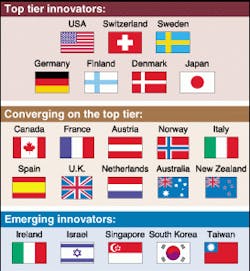America's prospects for future economic growth hinge on the private sector's ability to innovate and the federal government is encouraged by a new report from the Council on Competitiveness to encourage innovation. The report says the federal government should take steps to expand "the national capacity for innovation."
In fact, the report argues that the current debate over stimulating the economy to avoid a recession ignores larger issues that face high-technology industries and the general US economy.
"The production of high-value goods and services using the most advanced methods is the only way that we can continue to support our extraordinary wages" and return on capital, says the report, which was co-authored by Michael E. Porter, a professor at the Harvard Business School, and Debra van Opstal, a senior vice president of the council, a private group that includes representatives from industry, unions, and academe.
The nation's prosperity in the 1990s resulted from several factors, according to the report. Companies invested heavily in information technology, which boosted the productivity of workers; that growth in productivity, and Federal Reserve policies, produced low unemployment rates and low inflation; and the decline in borrowing by the federal government freed up capital for use by private industry. Meanwhile, the United States led the rest of the world in patenting, and entrepreneurs created new companies—and new jobs.
But at the same time, the report's authors note, personal saving rates dropped, federal spending on research declined or grew only slowly, and the nation produced fewer graduates in science and engineering (outside of life sciences) than US industry needed.
And simultaneously, other nations were taking steps to catch up with the United States. "The bar for competitiveness is rising because the global capacity for innovation is growing," the report states. "All advanced economies—and some emerging ones—are moving into the space once dominated by the United States." Other nations, for example, are producing trained technical talent more quickly than the United States and are investing in information technologies that once were the sole province of US companies.
Other countries are increasing government spending on research and development, as well. Overall, the nations that could be categorized as "top-tier innovators" now include Sweden, Germany, Finland, Denmark, Switzerland and Japan in addition to the United States, according to the report. In the face of such trends, the United States must take decisive steps to maintain its competitiveness, the report argues.
"Technological leadership is rooted in national investments in frontier research, a national cadre of scientists and engineers and state-of-the-art research facilities," the report argues. "In each of these areas, US innovation capabilities are eroding. These trends must be reversed to assure future prosperity."
In particular, the report calls on the federal government to spend more on research and development and to take steps to expand the numbers of technically trained workers." It also calls for steps to improve the technical training of the nation's workforce, by improving education in math and science, encouraging college education for minorities and low-income individuals, and expanding training programs. "The impending retirement of millions of baby boomers will leave a smaller and relatively less educated and experienced workforce," the report warns. "The ability to maximize the productive potential of every American of workforce age, through investment in education and training, will be essential to sustain future growth."
"In the short run, the vagaries of the economic cycle will capture the attention of Americans," the report says in its conclusion. "In the long run, the eroding base for innovation is the real challenge and the binding constraint on our standard of living."
